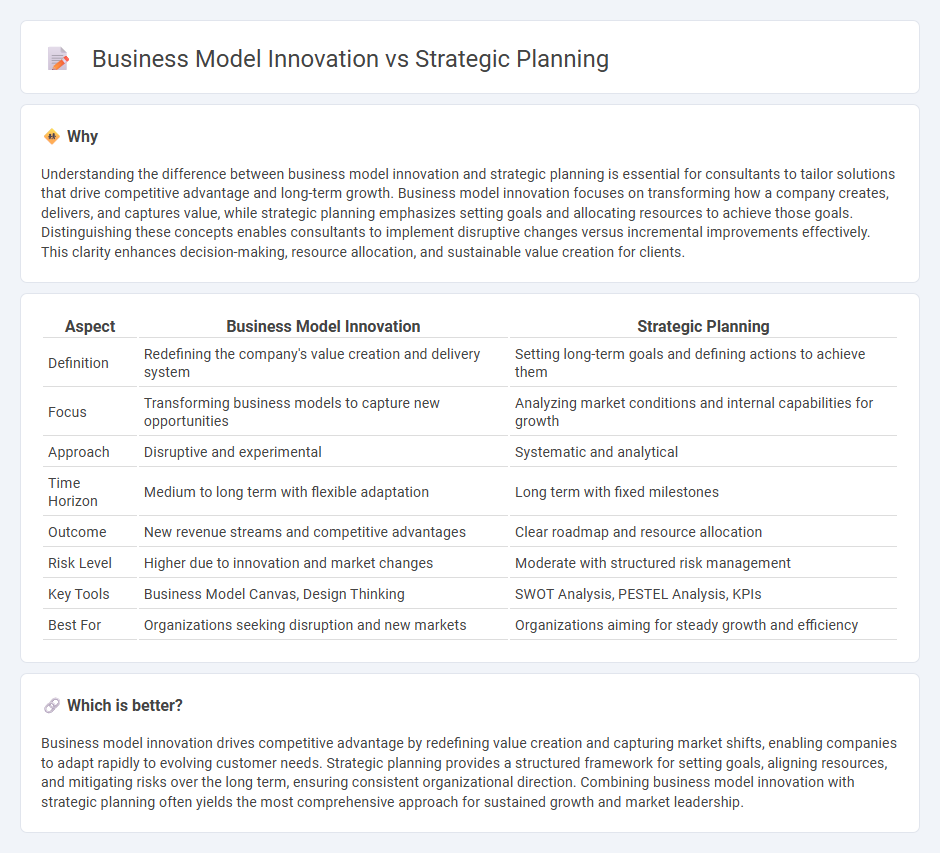
Business model innovation focuses on creating new value propositions and revenue streams through transformative changes in a company's core operations, while strategic planning emphasizes setting long-term goals and allocating resources to achieve competitive advantages. Consulting services often guide organizations to balance these approaches for sustainable growth and adaptation in dynamic markets. Explore how expert consulting can drive your business model innovation and strategic planning to outperform competitors.
Why it is important
Understanding the difference between business model innovation and strategic planning is essential for consultants to tailor solutions that drive competitive advantage and long-term growth. Business model innovation focuses on transforming how a company creates, delivers, and captures value, while strategic planning emphasizes setting goals and allocating resources to achieve those goals. Distinguishing these concepts enables consultants to implement disruptive changes versus incremental improvements effectively. This clarity enhances decision-making, resource allocation, and sustainable value creation for clients.
Comparison Table
| Aspect | Business Model Innovation | Strategic Planning |
|---|---|---|
| Definition | Redefining the company's value creation and delivery system | Setting long-term goals and defining actions to achieve them |
| Focus | Transforming business models to capture new opportunities | Analyzing market conditions and internal capabilities for growth |
| Approach | Disruptive and experimental | Systematic and analytical |
| Time Horizon | Medium to long term with flexible adaptation | Long term with fixed milestones |
| Outcome | New revenue streams and competitive advantages | Clear roadmap and resource allocation |
| Risk Level | Higher due to innovation and market changes | Moderate with structured risk management |
| Key Tools | Business Model Canvas, Design Thinking | SWOT Analysis, PESTEL Analysis, KPIs |
| Best For | Organizations seeking disruption and new markets | Organizations aiming for steady growth and efficiency |
Which is better?
Business model innovation drives competitive advantage by redefining value creation and capturing market shifts, enabling companies to adapt rapidly to evolving customer needs. Strategic planning provides a structured framework for setting goals, aligning resources, and mitigating risks over the long term, ensuring consistent organizational direction. Combining business model innovation with strategic planning often yields the most comprehensive approach for sustained growth and market leadership.
Connection
Business model innovation drives the redesign of value creation and capture mechanisms, directly influencing strategic planning by setting new objectives and resource allocations. Strategic planning incorporates these innovations to align organizational goals with emerging market opportunities and competitive advantages. Effective synergy between business model innovation and strategic planning enhances adaptability and long-term business sustainability.
Key Terms
Vision Alignment
Strategic planning ensures vision alignment by setting long-term goals and systematically allocating resources to achieve them, fostering organizational coherence and direction. Business model innovation drives vision alignment through redefining value propositions, customer segments, and revenue streams to adapt to market changes and competitive dynamics. Explore how integrating both approaches can optimize your company's strategic agility and sustained growth.
Value Proposition
Strategic planning centers on defining long-term goals, resource allocation, and competitive positioning to deliver value, while business model innovation redefines the value proposition by altering how products or services create and capture value for customers. Value proposition in strategic planning often emphasizes optimizing existing offerings, whereas business model innovation explores new ways to solve customer problems or fulfill needs dynamically. Explore how aligning these approaches can transform your value proposition and drive sustained growth.
Competitive Differentiation
Strategic planning emphasizes long-term goal setting and resource allocation to achieve competitive differentiation by analyzing market trends, customer needs, and competitor actions. Business model innovation redefines the value proposition, revenue streams, and operational processes to create unique market positions that are difficult for competitors to replicate. Explore further to understand how integrating these approaches drives sustainable competitive advantage.
Source and External Links
Strategic Planning Basics - Balanced Scorecard Institute - Strategic planning is the process of defining an organization's direction, priorities, and actions to achieve long-term success by setting goals, allocating resources efficiently, and measuring progress to ensure alignment with the mission and vision.
Strategic Planning: What, Why, How, Tools, Templates | Gartner - Strategic planning maps the actions needed to deliver on long-term strategy, enabling proactive decision-making, alignment of resources, consistent communication, and tracking progress toward functional and enterprise goals in a volatile environment.
What is strategic planning? | Definition from TechTarget - Strategic planning is a process in which organizational leaders define their vision, mission, measurable goals, and align short-term tactics with long-term strategy while periodically evaluating and revising the plan based on changing conditions.
 dowidth.com
dowidth.com